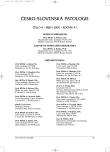BK-Virus Nephropathy and Simultaneous C4d Positive Staining in Renal Allografts
BK virus nefropatie a současný průkaz C4d v peritubulárních kapilárách v biopsiích ledvinných štěpů
V posledním desetiletí se do centra pozornosti v oblasti diagnostiky rejekce dostala snaha o identifikaci spolehlivého znaku, který by umožnil průkaz protilátkami vedeného poškození štěpů (humorální rejekci). Za diagnostický znak humorální rejekce jsou považována depozita C4d frakce komplementu v peritubulárních kapilárách (PTC) a průkaz C4d byl včleněn do diagnostických kritérií banffské klasifikace. V současnosti nejběžnějším virovým onemocněním transplantovaných ledvin je BK virová infekce (BKN). Tato afekce představuje důležitou příčinu dysfunkce s významným rizikem ztráty štěpu.
Od září 2000 do prosince 2003 jsme vyšetřili 1115 biopsií ledvinných štěpů a u 6 pacientů ve 12 biopsiích a 2 graftektomiích jsme diagnostikovali BKN. Průkaz viru byl proveden imunohistochemicky. Oba ledvinné štěpy byly vyjmuty kvůli selhání funkce, které způsobila BKN, u pacienta po kombinované transplantaci ledvina/pankreas. Pacient měl dobrou funkci štěpu pankreatu s nezbytným pokračováním imunosuprese. Detekce C4d byla provedena imunofluorescencí nebo imunohistochemicky. Ve vzorcích z graftektomií byla detekce C4d provedena imunohistochemicky a retrospektivně také ve všech případech s diagnózou BKN. Pozitivní průkaz C4d v PTC byl zjištěn v 9 z 12 jehlových biopsiích a v obou graftektomiích s BKN. Imunohistochemická detekce C4d odkryla koincidenci v lokalizaci BK virové infekce a depozit C4d v PTC.
Komplement představuje vývojově velmi starý systém zapojený v imunitních obraných mechanismech. Vazba C4d, koncového produktu časné fáze komplementové kaskády, na endotel peritubulárních kapilár je považována za průkaz humorální rejekce. V průběhu BKN se virus dostává do krevního řečiště pravděpodobně cestou PTC, současně endotel peritubulárních kapilár je také významným antigenem alloantigenní odpovědi. V místech s aktivní BKN mohou C4d depozita představovat výsledek aktivace komplementové kaskády lectinové cesty.
Klíčová slova:
transplantace ledviny – humorální rejekce – C4d – BK virus nefropatie
Authors:
E. Honsová 1; A. Lodererová 1; O. Viklický 2; P. Bouček 3
Authors‘ workplace:
Department of Pathology
1; Department of Nephrology
2; Department of Diabetology
Institute for Clinical and Experimental Medicine, Prague, Czech Republic
3
Published in:
Čes.-slov. Patol., 41, 2005, No. 4, p. 163-166
Category:
Short Communication
Overview
The role of antibodies in rejection of transplanted kidneys was the subject of debate at the last two Banff meetings and in medical journals. Diffuse C4d positive staining of peritubular capillaries (PTCs) was recognized as a marker of antibody-mediated rejection and this morphological feature was included in the updated Banff schema. At the same time polyomavirus infection of the renal allografts has been reported more frequently and is emerging as an important cause of renal allograft dysfunction and graft loss. At the present time, BK-virus nephropathy (BKN) represents the most common viral disease affecting renal allografts.
BKN was identified in 6 patients in 12 biopsies and 2 graft nephrectomy specimens of 1115 biopsies between September 2000 and December 2003. Definite virus identification was done by immunohistochemistry. The reason for graft nephrectomies was graft failure due to BKN in a recipient after kidney-pancreas transplantation with good function of his pancreas graft and the necessity of continuing immunosuppression. Detection of C4d deposits was performed by immunofluorescence or by immunohistochemistry. In graftectomy samples C4d detection was performed by immunohistochemistry and retrospectively in all cases of BKN. Focal C4d positive PTCs and BKN were found simultaneously in 9 of 12 needle biopsies and in both graft nephrectomy samples. Detection of C4d by immunohistochemistry disclosed focal C4d positive staining in kidney tissue but diffuse in the sites where BK-virus inclusions in tubular epithelial cells were found.
The complement system is part of the host defense response and is crucial to our natural ability to ward off infection. In cases of BKN, virus likely gains access to the bloodstream through injured tubular walls and via PTCs. Vascular endothelium in the PTCs represents a potential target antigen for alloresponse, and simultaneously possibly represents an imprint of complement activation or complement production in the places with BK-virus infection.
Key words:
renal allografts - BK virus nephropathy - C4d - humoral rejection
Labels
Anatomical pathology Forensic medical examiner ToxicologyArticle was published in
Czecho-Slovak Pathology

2005 Issue 4
Most read in this issue
- Autoimmune Gastritis. A Clinicopathologic Study of 25 Cases
- Melanoma Simulating Malignant Soft Tissue Tumour
- Pulmonary Veins and Atrial Fibrillation: A Pathological Study of 100 Hearts
- Gastrointestinal Stromal Tumor (GIST) with Glandular Component. A Report of an Unusual Tumor Resembling Adenosarcoma
